Introduction
TC Electronic has added to its catalog a new mini pedal at the beginning of 2022, named TC Impulse IR loader. It is an impulse response loader in pedal format, containing 12 official Celestion IRs, 8 IRs labeled “pedal-platform” and 5 IRs dedicated to players using electro-acoustic guitars. Due to its price and its format, it is aiming at the same segment as one of the references in this category, the Mooer Radar pedal. Small review of the TC Impulse to get an overview of the tone and features it provides.
TC Impulse : presentation
The TC Impulse is an IR charger offered by TC Electronic in a very compact format. Typical usage will be home-studio, or rehearsal and live situations, the pedal being typically placed at the end of your pedalboard, after drive or preamp pedals or after a load-box, with its output being sent to a mixer, a sound system or an FRFR speaker. TC Electronic, like Mooer with the Radar, aims for an extremely small footprint (by the way, the size of the TC Impulse is very close to the Radar, the TC being just a little bit wider, by 5 or 6 millimeters).
However, the philosophy is quite different: where the Radar offers many options to tweak and adjust your sound, the TC is stripped down and direct: it supports the rendering of IRs and has a global two-band EQ on board…. and that’s all !
The pedal is delivered in a Lilliputian box, with a USB cable, but without power supply. The pedal is equipped with a mini USB port, as on many other pedals from TC Electronic. The box displays two signatures : the one from TC Electronic but also Celestion: the two brands have setup a collaboration and the first 12 slots are occupied by official IRs from the famous British loudspeaker brand.
The pedal has two push buttons to change IR and access the global equalizer, as well as a volume potentiometer. The footswitch allows you to switch to A/B mode (i.e.two predefined IRs: IR A / IR B) or to bypass the pedal (a long press on the switch allows you to enter or exit A/B mode).
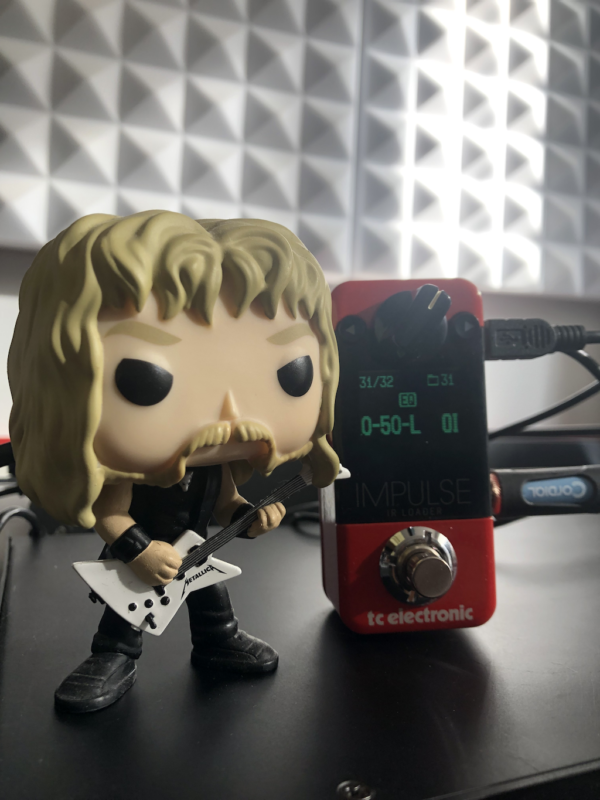
The indicators provided by the small screen are as follows:
- slot number (current IR)
- current IR file number
- IR/file name for custom IR
- EQ symbol: indicates that the small equalizer is on
- Two clipping indicators (IN/OUT) when the signal goes into saturation
The specs
TC Electronic does not communicate indications on dynamic range, latency or frequency rendering of the pedal… No information also on its sampling frequency. The TC videos simply say “24 bit uncompressed audio”. Not a big problem: when playing and listening to it, you can easily figure out that it provides a very solid restitution of IRs, with a very good audio quality and that the latency is negligible. The ability to use IRs with a length of up to 200 ms is highlighted by TC Electronic marketing, as many competing hardware loaders are limited to 23,2 ms.
The pedal offers 99 slots, the first 25 being loaded with original IRs offered by TC and Celestion:
- 12 Celestion IRs
- 8 “pedal-platform” IRs provided by TC
- 5 IRs for electro-acoustic guitars
The remaining 74 slots are available for your IRs.
The supported file formats are:
- a proprietary format: .uli
- the .wav format, in 16/24/32-bit PCM encoding, or .wav in 32-bit float encoding.
IR files with sampling frequencies of 44.1 kHz, 48 kHz or 96 kHz are supported. The IRs are truncated after 200ms, with a fade-out.
The pedal also includes a two-band equalizer:
- +/- 12 db low-shelf at 100 Hz
- +/-12db high-shelf at 10kHz
Small note: the power and USB connections are on the right side of the pedal. Choosing the rear side for these would have probably been more judicious for an easier integration in pedalboards…
Keep-it simple, stupid
Simplicity and sound are the main key words to characterize this pedal. The approach is very simple and direct. The loading of the IRs can be done with the software provided by TC or by directly copying IR files to the pedal which appears as a drive mounted on your PC or Mac (but TC recommends using the software). The software also allows you to make backups of the contents of the pedal.
The pedal starts in a few seconds and there you go… (after a little Matrix sequence on boot 🙂 )
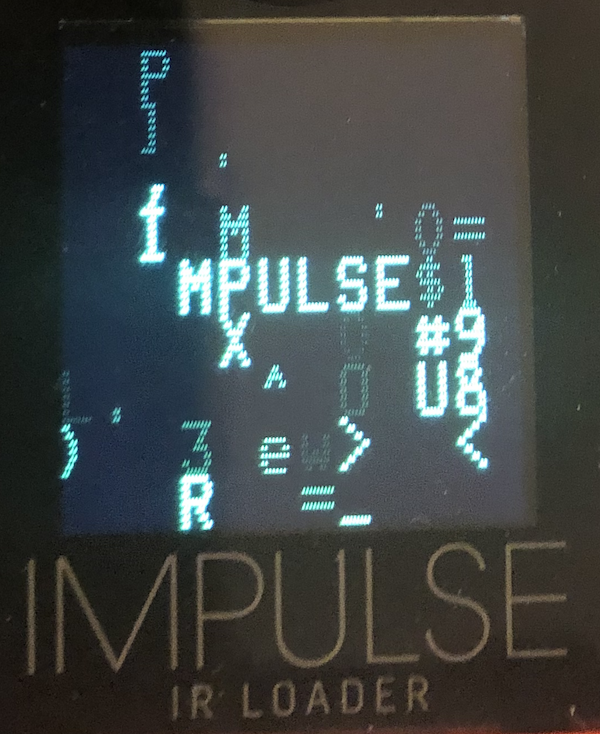
The 12 Celestion IRs are the following :
| File | Description | Cab Type | IR Type |
|---|---|---|---|
| 01 G12M 112 Celestion.uli | Celestion G12M Creamback | 1x12 Open back | Guitar |
| 02 Alnico Blue 212 Celestion.uli | Celestion Alnico Blue | 2x12 Open back | Guitar |
| 03 V30 412 Celestion.uli | Celestion Vintage 30 | 4x12 Closed back | Guitar |
| 04 G12M 412 Celestion.uli | Celestion G12M Creamback | 4x12 Closed back | Guitar |
| 05 G12-65 412 Celestion.uli | Celestion G16-65 | 4x12 Closed back | Guitar |
| 06 G12M Heritage 4x12 Celestion.uli | Celestion G12M-Heritage | 4x12 Closed back | Guitar |
| 07 G12M Greenback 4x12 Celestion.uli | Celestion G12M Greenback | 4x12 Closed back | Guitar |
| 08 G10 Greenback 4x10 Celestion.uli | Celestion G10 Greenback | 4x12 Closed back | Guitar |
| 09 G10 Vintage 2x10 Celestion.uli | Celestion G10 Vintage | 2x12 Open back | Guitar |
| 10 G12T-75 2x12 Celestion.uli | Celestion G12T-75 | 2x12 Closed back | Guitar |
| 11 Gold 1x12 Celestion.uli | Celestion Gold | 1x12 Closed back | Guitar |
| 12 BN15-300x 115 P All Celestion.uli | Celestion BN15-300x | 1x15 Ported | Bass |
These Celestion IRs are mixes of several microphones.
To check the tone of the pedal, I carried out my first tests using a configuration with an overdrive, a tube amp (Dual Rectifier), a load-box (Torpedo Reload), connecting the line output of the load-box to the Impulse pedal, then out to my sound card and output to my monitors. Some adjustments were necessary to adapt the level of the amp and the line level towards the input of the pedal as well as an adjustment of the volume on the pedal…
First observation: the pedal delivers excellent sound and you don’t notice any latency. The Celestion IRs are high quality: the V30 (03), the G12M (04), the G12-65 (05), the G12M Heritage (06), the Greenback (07) and the G12-T75 (10) were particularly good for nice high-gain sounds… Special mention also to the 4×10 Greenback (slot 08), which offers a very interesting sound…
I also tested 200 ms OwnHammer IRs, Catharsis IRs and my own Overdriven IRs (50 ms): the rendering seemed very good and faithful to me (similar to these same IRs loaded in software loaders under Logic ProX).
The small EQ is limited but well thought out: the low-shelf can effectively boost or reduce the low end. I initially thought that 10Khz would be a little bit too high for the high-shelf, but in the end it works well enough to temper or boost the top end, much like a presence setting.
So although this amp/load-box configuration allows you to gauge the sound quality of the pedal, the TC Impulse , due to its format and its line connectors, will more likely be used on pedalboard configurations with overdrive and distortion or preamps pedals. The TC Electronic presentation video also favors this pedal approach.
In this pedal-based scenario, it becomes a little bit more complicated -in my opinion- to get convincing high-gains sounds: you will be dependent on both the IRs you use on the TC Impulse and the voicing of your pedals. Some combinations of preamps with your IRs loaded on the Impulse may work well, even very well (that’s the case of my Mooer Cali MK3 and Cali Dual, for example) but for other pedals or with the FX Send of my amps, I have rather obtained sounds that were quite flat and dull or “dry” (Revv G4, Wampler Triple Wreck); and this even when cranking the bass/mids/treble/gain controls.… And, unlike the Mooer Radar, the TC Impulse does not include power amp simulators: so there is no “coloring” options, to get more resonance and to shape the sound, in order to diminish the transistor or digital side of the pedals…. Adding an EQ pedal in this type of setup will help in shaping further the tone :
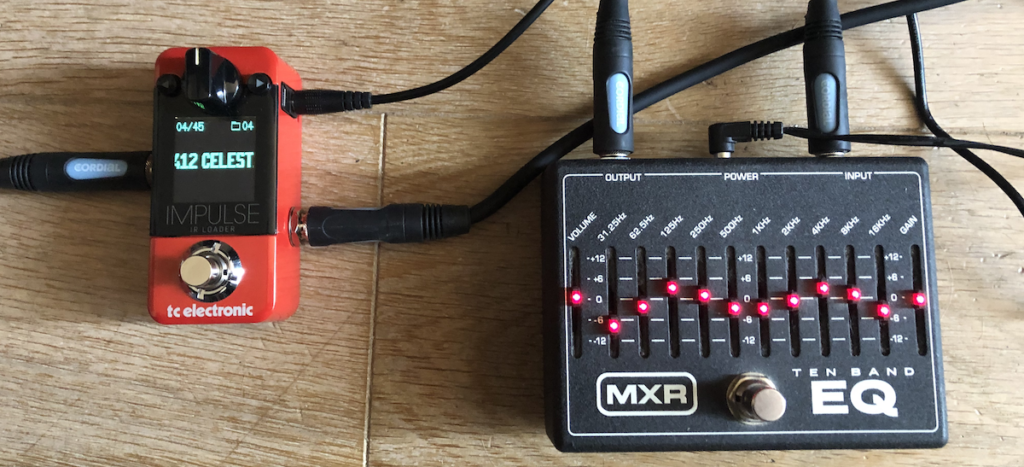
Note: these remarks are formulated for high-gain/metal sound only, and will basically apply to any IR loader that does not provide EQ or amp sims… The examples in clean, crunch, low-gain found on YouTube for the Impulse are quite good, with simply pedals and the Impulse…
To offer more options when pairing overdrive or distortion pedals with the Impulse, TC innovates by offering “pedal-platform IRs”.
Pedal-platform IRs
8 IRs of this type are supplied with the pedal: these are IRs captured via the clean channel of an amp AND a guitar cab. They therefore provide a signature that is intended to be equivalent to that of an amp that is used to connect distortion pedals or overdrives (to the guitar input of the amp). In this case, TC recommends putting all your pedals before the Impulse, including delay and reverb pedals, but you can of course experiment and decide otherwise….
Here are the descriptions of these 8 IRs:
| Filename | Amp type | Cab type | IR Type |
|---|---|---|---|
| 13 BH-HD15 + G12M Cream.uli | Blackheart HD15 | 1x12 Open back | Amp+Cab |
| 14 Dmn + JS 1960-G12T5.uli | Demon B CUSTOM | 4x12 Closed back | Amp+Cab |
| 15 Engl + G12M-Heritage.uli | Engl Sovereign | 4x12 Closed back | Amp+Cab |
| 16 DSL + JS 1960-G12T5.uli | Marshall DSL | 4x12 Closed back | Amp+Cab |
| 17 800 + V30 412.uli | Marshall JCM800 | 4x12 Closed back | Amp+Cab |
| 18 900 + G12M Green.uli | Marshall JCM900 | 4x12 Closed back | Amp+Cab |
| 19 Badge + G10 Vintage.uli | Suhr Badger | 2x10 Open back | Amp+Cab |
| 20 AC30 + Gold.uli | VOX AC30 | 1x12 Closed back | Amp+Cab |
I didn’t get very convincing high-gain/metal sounds with this approach, at least with the pickups/overdrive/preamps I use (I tried with an OD808, a Precision Drive, an OD Glove, and OCD): you really have to hit these IRs with a very high level drive to make them sound… Using the Cali MK3 or the REvvG4 used in a distortion way, I could obtain “some” sounds, in particular by using the IR n ° 15 (Engl), but I did not end-up in the tone area that I usually enjoy.… These IRs do provide color and resonance but this remains limited -IMHO- : you will have to try matching the voicing proposed by the IR with your drive or distortion pedals…. TC’s introductory video does, however, offer “ok” sounds for crunch or mid-gain with these IRs, so if you’re more into playing with those types of sounds, it might work for you and your gear.
So 8 voicings with these 8 IRs: that’s not bad, but it’s still limited. Will TC offer additional IRs of this type in the future, to expand the possibilities?
Some links to get an idea:
- Official TC Electronic video: https://www.youtube.com/watch?v=tRY1f97Zgro
- Example using a Joyo Zip Amp and pedal-platform IRs: https://www.youtube.com/watch?v=G3UKuKsVIsc
- Example with rather clean and crunch sounds: https://www.youtube.com/watch?v=dfRW_Y4_a5Q (example with a Strymon Riverside)
Acoustic guitar IRs
Slots 21 to 25 are occupied by 5 acoustic guitar IRs. These are the following:
| Filename | Description |
|---|---|
| 21 ACU TC BLEND.uli | Carefully mixed and blended IR from several instruments |
| 22 ACU FRM 57.uli | FRAMUS 57 |
| 23 ACU BARBERA.uli | HAMBLIN BARBERA |
| 24 ACU D28.uli | MARTIN D28 |
| 25 ACU EF341.uli | TAKAMINE EF341SC |
They are primarily intended for guitars equipped with piezo pickups. TC indicates that they can also be used with an electric guitar, this time with a suggested placement of the Impulse at the very beginning of the chain.
The software
It is very simple and provides support to import your IRs. It also allows you to backup and restore the pedal.
The export bundle function creates a zip containing all the folders where an IR is present, a folder containing either a .uli (slots 1 to 25), or the .wavs that you have loaded. Conversely, the import bundle function reloads your zip to the pedal: practical for configuring/restoring the pedal in one operation. Loading IR is done via drag and drop to the pedal window. You can rename, move or delete an IR very easily: all this is done instantly. Practical, simple and effective.
The pedal supports IRs of 200 ms maximum and will apply a fade-out on longer IRs: TC Electronic recommends using the software rather than copying the files directly via your Finder or Windows file explorer (by the way in this case, the name of the IR appears in yellow in the interface, probably to indicate that you did not use the software to install it).
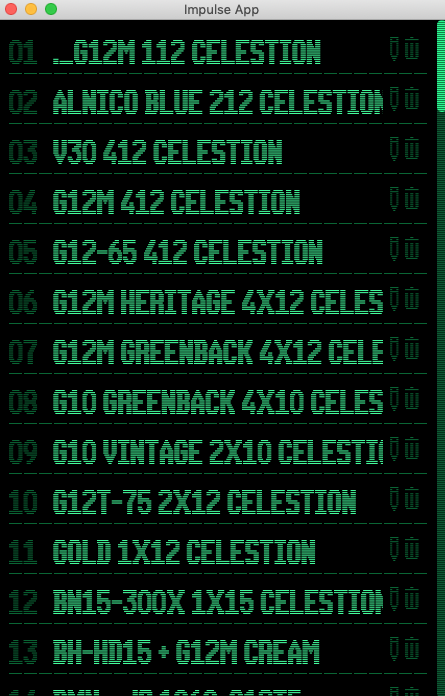
Note that when the USB connection is established, the IR loader is “disengaged” or put in a particular/generic rendering mode: you must then disconnect the USB cable for the pedal to resume normal operation, after having loaded your IRs …
A few examples
Small examples to illustrate the sounds delivered by the pedal, in high-gain:
- Sample 1 to 10: EMG 81 Drop D/Fishman7 B tuning, Precision Drive, Dual Rectifier CH3 modern (almost all at noon), Torpedo Reload, TC Impulse, sound card. The gain setting may be a bit high…
- Sample 11: Fishman7 B tuning, Precision Drive, Mooer Cali Dual, TC Impulse
- Sample 12: same but Cali MK3
- Sample 13: EMG81 drop D, Mooer Cali-MK3, Engl CabLoader left channel, TC Impulse right channel, same IR Overdriven FB-DEM-SM57, 50 ms
- Sample 14: EMG81 drop D, Mooer Cali-MK3, Engl CabLoader left channel, TC Impulse right channel, same IR OwnHammer DZL 412 160 00, 200 ms
IRs used on samples:
- 1: Celestion G12-65 412*
- 2: Celestion V30 412*
- 3: Celestion G12M 412*
- 4: Celestion G12M Heritage 412*
- 5: Celestion G12-T75 212*
- 6: Overdriven OD-FB-DEM-US-8 212 (50ms)
- 7: Overdriven OD-E112-GOV-US-8112 (50ms)
- 8: OwnHammer DZL-ORN 412 (200ms)
- 9: Overdriven OD-FB-K100 212 (50ms)
- 10: Overdriven E112 G12-65 112 (50ms)
- 11: Overdriven E112 G12-65 112 (50ms)
- 12: Celestion G12-65 412*
- 13: Overdriven FB DEM
- 14: OwnHammer Dzl 412 V30 160
*= Celestion IRs provided with the pedal.
Screen capture below : 1024 points IR loader against TC Impulse, same IR: in red the 200 ms IR on the Impulse, more precise on the bottom of the spectrum.

Conclusion
Very compact, simple, easy to use, support for IRs up to 200 ms, imperceptible latency and very good sound quality: these are clearly the advantages of this pedal. If you use a load-box behind an amp, it will ensure faithful rendering and will provide you with very good sound quality.
Even excellent 200ms IRs may not be enough to get interesting metal or high-gain sounds with pedals-only setups… -according to my preferences and my hardware-….In this case, the TC Impulse may prove to be less flexible than a pedal like the Mooer Radar -for example- because the Impulse’s EQ remains very limited and you may also suffer from the lack of power amp simulation (6L6, EL34, etc.): the sound can be in this case a little bit too dry or flat. In this pedal-only scenario, the voicing of the distortion or preamp pedals is preponderant and -in my case- the rendering offered by the pedal-platform IRs was not convincing. The pedals that have given me the best results were the Mooer Cali Dual and the Mooer Cali MK3, using conventional IRs (BTW, these little Mooer preamps sound really great).
To improve the tone you may try tweaking your IRs: for example, equalize them before loading them on the Impulse… Or you could go in search of IRs that match better your pedals and provide the sound you are looking for. Or add an equalizer pedal in the signal chain for more tone options…
A very compact charger, with a good sound and a faithful rendering of IRs, very easy to use… Metal or high-gain players -who would like to use the Impulse in pedals-only setups- may need additional pedals such an EQ to get into their favorite tone area…
Approx. 135 Euros on 09/2022.
Product page, manual and software : https://www.tcelectronic.com/product.html?modelCode=P0EBH
Change log
- Created : 09/22/2022
- Edits : 09/23/2022
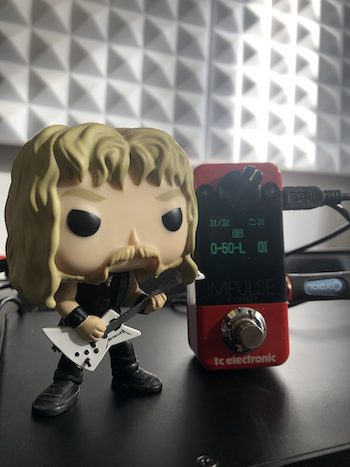
2023-12-30 at 00:54
Thanks for the very thorough review. One question remains:
What sample rate most closely matches the native format of the .uli files?
Is it 44.1k like the Mooer or 48k like the HX Stomp?
2024-01-04 at 10:01
Thanks for the comment Joe. I think the native format of the .uli is not document, though TC states the formats supported on import and it is among one of the most flexible as far as I know : “Supported formats: .wav files, 16/24/32-bit fixed (PCM), and 32-bit float
Supported rates: 44.1 kHz, 48 kHz, 96 kHz” (from TC Impulse doc).
David